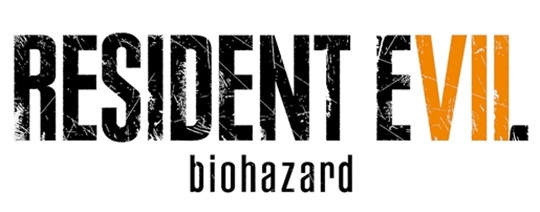
At the last E3, I was taken aback by the announcement of Resident Evil 7, as it resembled nothing I knew about the series. From the first person perspective to the photo-realistic graphics, RE7 was more similar to other horror games than it was to its predecessors.
When the game launched in January this year, the fans’ concerns about the franchise were largely proven to be unfounded. Despite the difference in appearance, RE7 heavily reminded me of past installments the more I dug into the game.
Capcom Senior Manager Peter Fabiano took the stage at GDC to give an inside look at how the company took the Resident Evil franchise in a new direction by maximizing horror and staying true to the original concept.

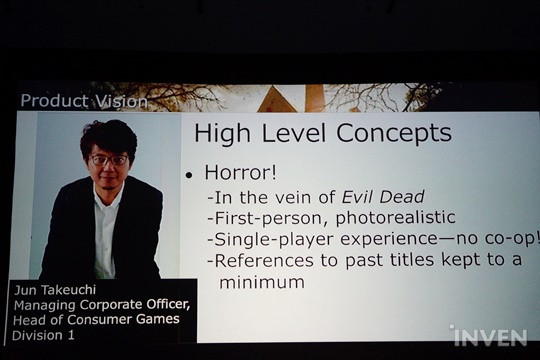
Back in Osaka, 2014, Jun Takeuchi of Consumer Games Division 1 and Director Koshi Nakanishi got together to work on a new vision for the next Resident Evil. At the time, Takeuchi built some high level concepts, among which was more emphasis on horror. He also intended to use other follow-up concepts such as using photo-realistic graphics reminiscent of Evil Dead, using a first-person view, and focusing exclusively on a single player experience while eliminating co-op aspects. Lastly, he wanted to keep references to past titles to a minimum.
To recreate the Evil Dead nuances, Takeuchi had to keep the maximum number of characters to five and had to convey claustrophobic feelings centered around a derelict mansion. By using a small, confined space rather than a wide, open one, he aimed to add depth to the game’s development.
As the fans of the franchise are already aware, the first three Resident Evil titles used a fixed camera angle to amplify horror, whereas the fourth game to sixth one used a third-person view to complement action elements. This time, Capcom challenged themselves with RE7, using photorealism and a first-person perspective to reinvent the series.
To create the best possible horror atmosphere, the development team decided to narrow the game’s focus on the single player experience while abandoning multiplayer. The team also did away with characters from past titles like Leon Kennedy and Chris Redfield, which allowed the game to progress from the player’s experience instead of following the stories of prominent characters.

It was not a rash decision to develop RE7 in a new direction. Ever since the release of RE6, Capcom had internal debates about where to take the franchise. Nakanishi was among the people who voiced similar concerns about the series and thought that Resident Evil needed to redefine itself.
To achieve that goal, he went back and had to reassess what made Resident Evil unique. Since the gaming market was already saturated with shooting games with zombies, it was important to set the goal of making RE7 a truly terrifying experience.

With those things in mind, the team began designing a completely revamped Resident Evil game in February of 2014. The first design goal was to recreate the feelings people felt when playing the original Resident Evil. To that end, they had to convey the sensation of being trapped in the unfamiliar mansion by adding interesting enemies. The main protagonist also had to be unknown to players, as people were new to Chris and Jill when they first experienced the game. In short, the dev team intended to build suspense and fear by introducing unknown characters and environments.
After establishing a fundamental development direction, the team was tasked with designing memorable characters. The enemies in RE7 had to bring in live facial expressions and eerie movements, which made players constantly second-guess who their enemies really are.
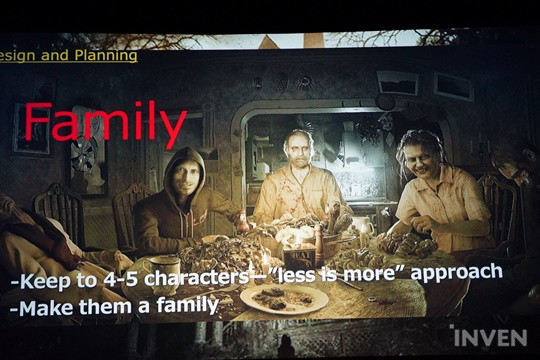
Using an unknown mansion in the level design, the developers took a Metroidvania approach to the map layout rather than a linear one in order to effectively use all the confined spaces. As such, players were able to find their bearings, solve puzzles, and explore new areas under the looming fear of being trapped.
As the speaker mentioned previously, it was necessary to keep the number of characters to four or five in order to convey the nuances of Evil Dead. So, the developer made them a family to highlight this characteristic.

One critical problem with the horror genre is that people no longer feel terrified as they adapt to the settings. Resident Evil players must overcome the horror so that they can take down enemies. The intensity of horror took a nosedive as soon as players discovered what was previously unknown and understood how to deal with them,.
Consequently, the team tried to mix and match horror elements from various horror subgenres. For example, they assigned Jack, the head of the household, with slasher film tropes and his wife Marguerite, with body and natural horror features like disfigured body parts and insects.
Even aggregating all those elements did not quite express the extreme horror they were aiming for. The final goal was to find ways of immersing players in this confined space. In addition to photo-realistic graphics, the first-person view, and unknown characters, the team decided to implement VR for the first time in its series.

To reach the goal of delivering palpable horror, the developer not only had to decide what they should do, but had to decide what they should not do. For one, the game dropped familiar characters, action aspects, multiplayer features, and the blockbuster movie-like cutscenes. They also had to do away with zombies, which were now anything but scary.
It was meaningful work done to set new design and concept goals for the next Resident Evil. However, loyal fans of the franchise sometimes become aversive to drastic changes. How will the fans respond to these changes in the game?
To gauge the reception, the team look a long and hard look at feedback collected based on the twenty years of the Resident Evil franchise. From the analysis, they listed the features fans enjoyed the most: namely, iconic characters, familiar story, horror, puzzle, co-op, and fixed camera angle. In other words, all the elements they sacrificed for RE7 turned out to be the ones fans loved.
Still, Capcom didn’t abandon their plan. Believing that appealing to everyone is the same as appealing to no one, they decided to go ahead with their design.
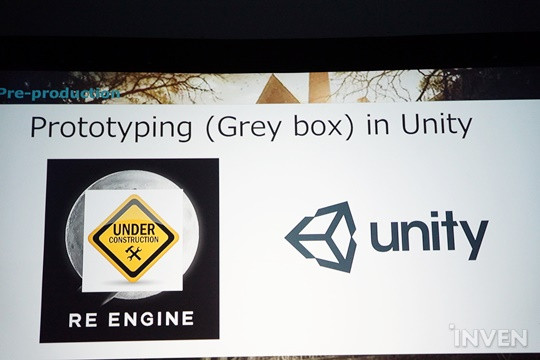
Prior to the actual development, the team researched horror by watching scary films together and visiting abandoned houses to set the tone for the project. Going to Louisiana, the place of the game, was also a valuable experience that helped draw inspiration.
Since the company’s custom RE Engine was not complete in the early development, the developer used Unity to create a prototype. They built samples based on previous ideas and iterated on those ideas to study how to intensify horror.
During this stage, the team focused on putting together anything of interest and creating a safe space for anyone to try out new ideas. To achieve this end, the company had to tear down the boundaries between traditional teams and encouraged anyone to contribute their ideas regardless of the titles within the company. Additionally, Capcom implemented agile software development in which established teams were divided up into smaller teams. As a result, the development environment came to closely resemble that of an indie development team.
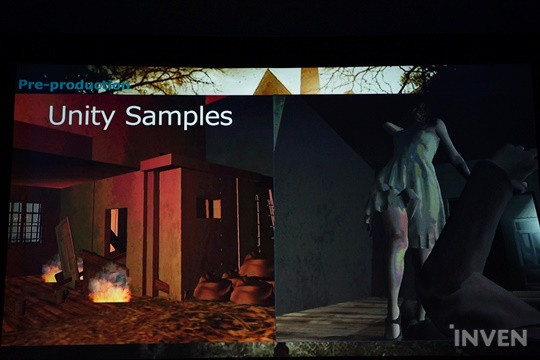
These small groups, which split from previous teams, were then assigned names according to their specific parts in the project such as “father team”, “mother team”, “brother team”, and “grandmother team” (others included). For instance, father team will oversee Jack, meanwhile grandmother team covers everything miscellaneous.
With the restructuring, team members were more in tuned with one another within the team and were able to develop somewhat of an owner’s mindset. On the other hand, it came with a few downsides as some people struggled with adjusting to a new organization and people from different teams seemed disjointed.


When Capcom’s RE Engine was finished in April 2015, Takeuchi demanded a higher standard for the development team. As the launch date drew near, the team had to make several changes to the game to meet the new standard.
First off, the team added separate branching paths to the ending. Since there wasn’t enough time to create entirely different endings, the developer tried to reflect the urgency of being at a crossroad by giving players a choice to save either Mia or Zoe.
In a similar vein, RE7 was a departure from the common theory about learning curve. Typically, games first introduce players to mechanics then let them draw from their knowledge to progress. Instead of the conventional learning curve, RE7 had players attempt to use unfamiliar objects to beat bosses.
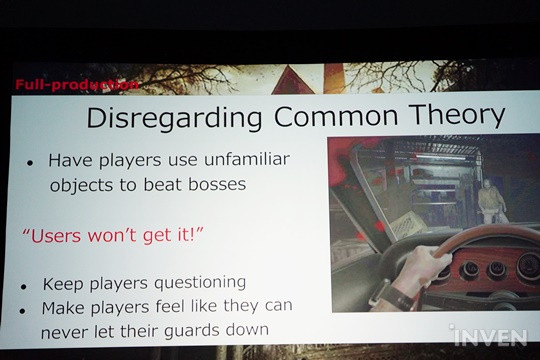
A prime example is the parking lot fight with Jack. Players will quickly realize while facing him that no gun or knife is enough to beat him. As players scramble around the parking lot avoiding Jack, they will come across a car key on a shelf, which gives players a choice to attack him with a car.
By not providing basic hints, RE7 successfully makes players constantly question everything and always keeps them on their toes.
Before launch, Capcom released a demo for playtesting purposes. This was especially important for RE7 because the development team was able adjust the pace between suspense and relief as well as smooth out balance in stressful stages from these playtests. Additionally, the team was able to learn where and when players consumed and replenished items.
With these multiple processes behind the scene, Resident Evil’s seventh incarnation was born. The dev team is currently working on new DLC releases to add a variety of horror atmospheres and gameplay. Fans will rejoice as the free DLC, Not A Hero, featuring beloved characters from the previous titles, will be released this spring.


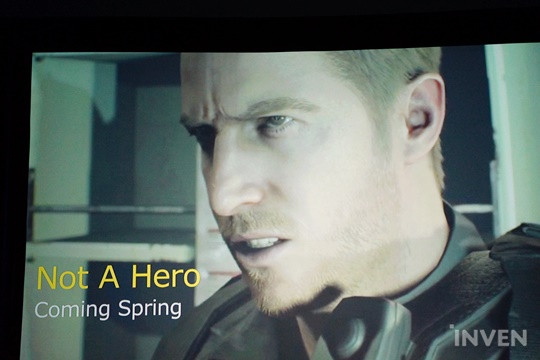
Sort by:
Comments :0







